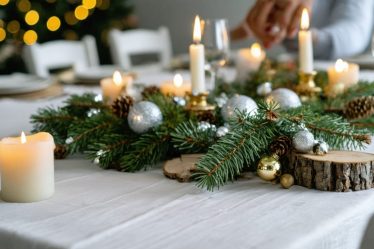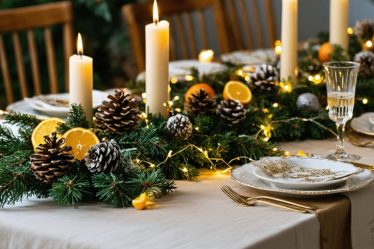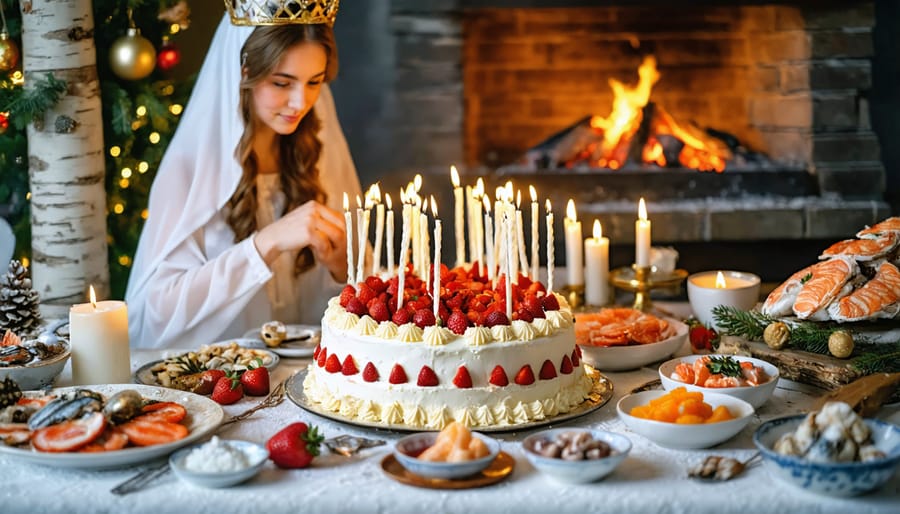
Step into a world where cherished traditions transform ordinary moments into lifelong memories. From the luminous Swedish St. Lucia celebrations to Japan’s Christmas Eve KFC feasts, holiday customs reveal humanity’s beautiful diversity in celebrating togetherness. These holiday recipes that connect cultures do more than fill our plates—they weave stories of heritage, family, and joy across generations.
Imagine lighting your first Hanukkah candle alongside families worldwide, or joining millions in Mexico as they savor midnight tamales on Noche Buena. Each tradition, whether centuries old or newly created, adds a unique brushstroke to our global holiday canvas. In kitchens and homes across continents, people are reimagining these customs, blending time-honored practices with modern twists to create celebrations that feel both authentic and fresh.
As we explore these fascinating traditions together, you’ll discover not just recipes and rituals, but inspiration to craft your own meaningful holiday moments. Whether you’re looking to honor your heritage or create new family traditions, these global celebrations offer a treasure trove of ideas to make your holidays truly special.
Enchanting Winter Celebrations in Scandinavia
Swedish Santa Lucia Day
As the dark winter days descend upon Sweden, a magical tradition illuminates homes and hearts across the country. Every December 13th, young women don white dresses and crown themselves with candle-lit wreaths to celebrate Santa Lucia Day, one of Sweden’s most enchanting eco-friendly holiday celebrations.
The celebration begins at dawn when the eldest daughter of each family transforms into Lucia, the bearer of light. She wears a white gown tied with a red sash and a crown adorned with lingonberry branches and glowing candles. Following an ancient tradition, she serves her family warm saffron buns (lussekatter) and coffee or mulled wine (glögg) in their beds.
The night before, Swedish families prepare their beauty rituals, often including a relaxing candlelit bath infused with pine needles and applying moisturizing face masks to combat the harsh winter air. The traditional saffron buns are shaped like figure-eights and flavored with warming spices, filling homes with an irresistible aroma that signals the start of the holiday season.
In schools and offices across Sweden, groups of young people form processions, singing traditional Lucia songs while holding candles. The combination of flickering lights, heavenly voices, and the scent of freshly baked treats creates an atmosphere that perfectly captures the magical essence of this Nordic celebration.
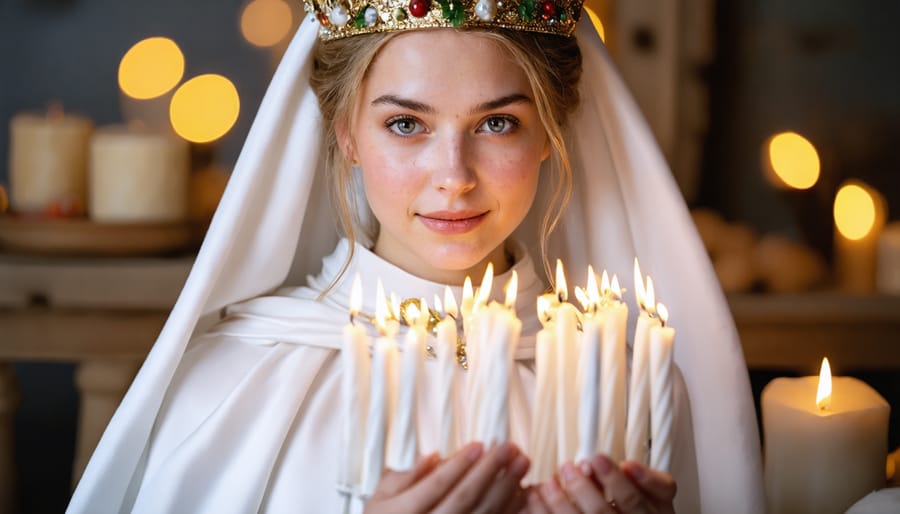
Finnish Christmas Sauna Rituals
In Finland, Christmas Eve isn’t complete without the cherished tradition of the holiday sauna, a ritual that beautifully combines wellness and festivity. As someone who experienced this tradition firsthand during a winter visit to Helsinki, I can tell you it’s pure magic!
Finnish families typically begin their Christmas celebrations with an afternoon sauna session, usually around 3 PM. The sauna is specially prepared for this occasion, with fresh birch branches releasing a delightful aroma and candlelight creating a peaceful atmosphere. It’s believed that the ‘sauna elf’ (saunatonttu) protects the sacred space, so families often leave out a small portion of porridge as a gesture of respect.
What makes the Christmas sauna extra special is its role in preparing both body and mind for the holiday festivities. The warmth of the sauna, typically heated between 80-100°C, helps release tension and create a sense of purification before the celebration begins. Many Finns alternate between the hot sauna and rolling in the snow outside – a practice said to boost circulation and immunity.
Modern Finnish families have adapted this tradition while keeping its essence intact. Some add seasonal touches like pine-scented oils or playing soft Christmas music. The ritual concludes with everyone feeling refreshed and ready to don their holiday best for the evening’s festivities.
Festive Foods That Tell A Story
Italian Feast of the Seven Fishes
For many Italian-American families, Christmas Eve means gathering around a table laden with an abundance of seafood dishes in celebration of the Feast of the Seven Fishes. This cherished tradition, known as “La Vigilia,” has been passed down through generations, creating treasured family recipes that bring loved ones together each holiday season.
The feast traditionally features seven different seafood preparations, though some families serve up to thirteen dishes! Each offering holds special significance, from the classic baccalà (salt cod) representing preservation and sustenance to the delicate frutti di mare celebrating the abundance of the sea. Popular dishes include garlic-infused linguine with clams, crispy fried calamari, and tender shrimp scampi swimming in white wine and butter.
What makes this tradition particularly special is how it’s evolved while maintaining its core values. Modern celebrations might include contemporary twists like pan-seared sea bass with herbs or citrus-marinated salmon, alongside traditional favorites. The preparation often becomes a joyful family affair, with different generations working side by side in the kitchen, sharing stories and techniques.
If you’re inspired to start your own Seven Fishes tradition, begin with a few approachable dishes. A simple seafood stew, some perfectly grilled shrimp, and a light fish appetizer are excellent starting points. The key is creating an atmosphere of warmth and celebration, rather than stressing over having exactly seven dishes.
Remember, while the seafood is central to the feast, it’s the gathering of loved ones that makes this tradition truly magical. Set your table with care, light some candles, and embrace the Italian way of taking time to savor both the food and the company. This beautiful custom reminds us that holiday traditions are about creating meaningful moments with those we cherish most.
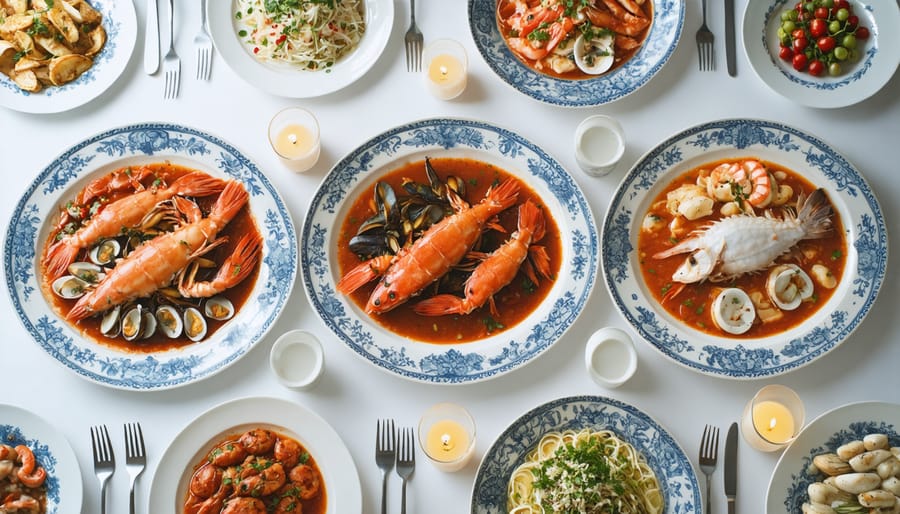
Japanese Christmas Cake Tradition
Picture this: a fluffy white cake adorned with perfect strawberries and whipped cream, sitting in a pristine bakery window on Christmas Eve in Tokyo. This isn’t just any dessert – it’s the iconic Japanese Christmas cake, a beloved tradition that perfectly captures the blend of Eastern precision and Western influence in modern Japanese culture.
I’ll never forget my first Christmas in Japan, watching families carefully carrying these beautiful cakes home in their signature white boxes. The tradition began in the post-World War II era when Japan was embracing Western customs and celebrating its growing prosperity. The white whipped cream symbolized snow, while the red strawberries added a festive pop of color that perfectly matched Christmas decorations.
Today, this simple yet elegant dessert has become more than just a cake – it’s a symbol of celebration and family togetherness. While the classic version features light sponge cake layered with fresh cream and strawberries, modern Japanese pastry chefs have begun creating their own interpretations. You might find versions with matcha cream, chocolate decorations, or even character-themed designs that children adore.
What makes this tradition particularly special is its timing. Japanese families typically enjoy their Christmas cake on Christmas Eve, often after a dinner of Kentucky Fried Chicken (another unique Japanese Christmas tradition!). The cake-cutting moment is considered a highlight of the holiday celebration, with everyone gathering around to take photos and share in the joy.
If you’re inspired to start your own Japanese Christmas cake tradition, remember that presentation is key. The cake should look as beautiful as it tastes, with perfectly arranged strawberries and smooth, white cream. Many home bakers have begun crafting their own versions, adapting the recipe to suit their families’ tastes while keeping the essential elements that make this dessert so special.
Beauty Rituals and Holiday Preparations
Moroccan Hammam Holiday Preparations
As the holiday season approaches in Morocco, families prepare for celebrations with a cherished ritual that’s both spiritually cleansing and beautifully pampering – the traditional hammam visit. I’ll never forget my first experience with this time-honored tradition during a winter stay in Marrakech, where local friends introduced me to this transformative pre-celebration custom.
The hammam, a steam room and bathing facility, becomes especially busy before major festivities. Women gather with their mothers, sisters, and friends, bringing natural black soap, kessa exfoliating gloves, and rhassoul clay masks. The ritual begins in a warm steam room, where the heat opens pores and relaxes muscles. Then comes the thorough exfoliation with black soap, followed by a vigorous scrub with the kessa glove that reveals gorgeously soft skin underneath.
What makes this holiday preparation so special isn’t just the physical renewal – it’s the social bonding. Women share beauty secrets passed down through generations, exchange holiday recipes, and catch up on family news. The application of rhassoul clay marks the final stage, leaving skin glowing and ready for celebration attire.
Modern Moroccan women often add their own twist to this tradition, incorporating aromatic oils like argan or rose, and some even host private hammam parties in their homes. Whether traditional or contemporary, this beautiful ritual reminds us that holiday preparations can be more than just rushing through to-do lists – they can be moments of self-care and connection that make the celebrations even more meaningful.
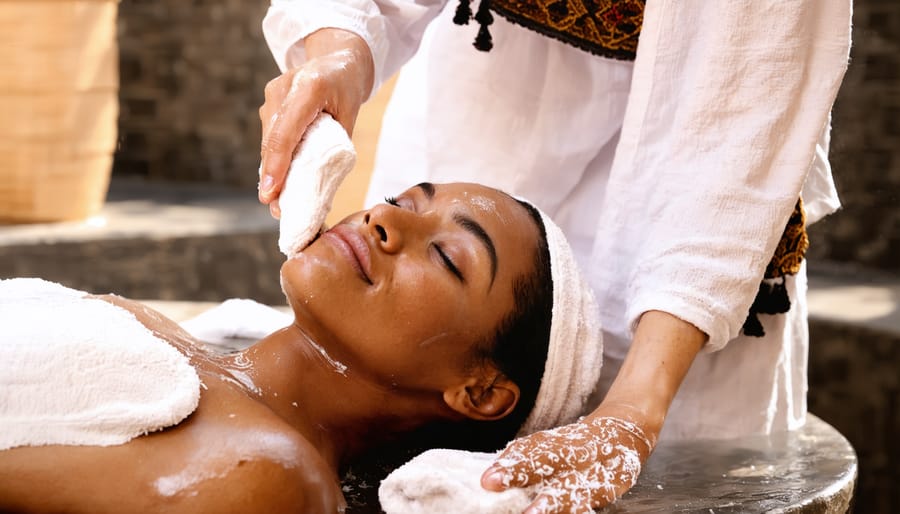
Indian Diwali Beauty Traditions
As someone who’s celebrated Diwali with Indian friends, I’m always amazed by how beauty rituals play such an essential role in this vibrant festival. During the five-day celebration, women across India embrace centuries-old beauty traditions that go far beyond just looking good – they’re about self-care, renewal, and spiritual preparation.
The preparations typically begin with ubtan, a traditional body scrub made from turmeric, gram flour, and herbs. This natural exfoliant leaves skin glowing and is often shared among family members as they prepare for the festivities together. Many women also indulge in oil massage treatments called abhyanga, using warm sesame or coconut oil to nourish their skin and hair.
Henna application, or mehndi, is perhaps the most recognizable Diwali beauty tradition. Women gather for mehndi parties where intricate patterns are drawn on their hands and feet, believed to bring good fortune. The darker the henna stains, the more luck it’s said to bring!
Another beautiful tradition is the pre-Diwali hair oiling ceremony. Mothers and daughters often sit together, massaging warm oil into each other’s scalps – a practice that not only nourishes the hair but strengthens family bonds. Many also apply a face mask of saffron and milk, known for its brightening properties.
On Diwali night, women dress in their finest clothes and jewelry, but it’s the inner radiance from these self-care rituals that truly makes them shine. These beauty traditions remind us that taking care of ourselves isn’t just about external appearance – it’s about connecting with our heritage and loved ones while nurturing our well-being.
As we’ve journeyed through these fascinating holiday traditions from around the world, it’s clear that celebration knows no boundaries. What strikes me most is how each culture has found unique ways to express joy, gratitude, and connection during special times of the year. These traditions remind us that there’s no single “right way” to celebrate – instead, they invite us to explore and create meaningful rituals that resonate with our own lives.
Consider incorporating elements from these global celebrations into your own holiday routine. Perhaps you’ll be inspired by the Japanese tradition of winter baths to create a spa-like experience at home, or maybe the Swedish custom of lighting candles will encourage you to craft your own festive ambiance. These adaptations don’t have to be grand gestures – sometimes the smallest touches make the biggest impact in creating mindful holiday celebrations.
What’s beautiful about holiday traditions is their ability to evolve while maintaining their essence. You might blend your family’s long-standing customs with newly discovered practices, creating something uniquely yours. For instance, try incorporating natural ingredients from different cultural beauty rituals into your holiday self-care routine, or experiment with fusion holiday recipes that honor multiple traditions.
Remember, the most meaningful traditions are those that bring joy and connection to your life and the lives of those around you. Whether you’re drawing inspiration from the vibrant festivals of India, the cozy hygge practices of Denmark, or the nature-centered celebrations of New Zealand, let these global traditions spark your creativity and enhance your holiday experience.
As we wrap up our exploration of these wonderful customs, I encourage you to approach your next holiday season with fresh eyes and an open heart. What new traditions will you create? How will you make this season uniquely yours while honoring the beautiful diversity of celebrations around the world?

